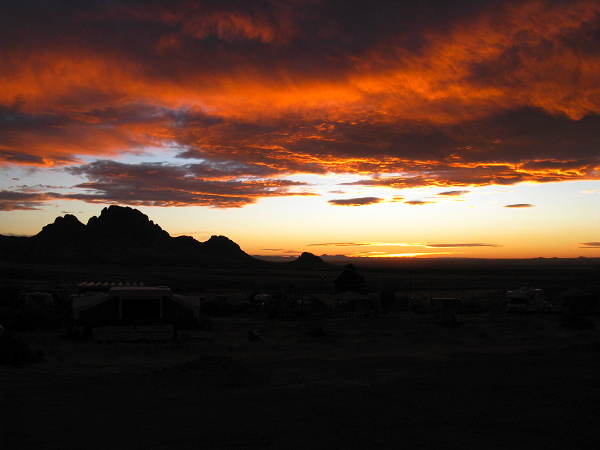Monday, February 9, 2009 - Rockhound State Park, Deming NM
< previous day | archives | next day >

Sunset, Rockhound State Park, Deming NM, February 7, 2009
URGENT - WINTER WEATHER MESSAGE
To quote today's NWS Winter Weather Advisory :
URGENT - WINTER WEATHER MESSAGE NATIONAL WEATHER SERVICE EL PASO TX/SANTA TERESA NM 1130 AM MST MON FEB 9 2009
...WINTER STORM SYSTEM TO BRING STRONG WINDS AND SNOW TO SOUTHERN NEW MEXICO TONIGHT AND TUESDAY...
.ANOTHER PACIFIC STORM SYSTEM WILL MOVE INTO THE REGION TONIGHT AND PASS THROUGH SOUTHERN NEW MEXICO AND FAR WEST TEXAS ON TUESDAY. THIS STORM SYSTEM COLDER AND STRONGER SYSTEM THAN THE ONE THAT MOVED THROUGH THE AREA ON SUNDAY. ACCOMPANYING THIS SYSTEM WILL BE A POWERFUL UPPER LOW AND A STRONG SURFACE COLD FRONT. INCREASED MOISTURE AND INSTABILITY WILL HELP TO GENERATE SCATTERED SHOWERS ACROSS THE REGION...BEGINNING AROUND MIDNIGHT OVER THE GILA AND BOOTHEEL AREAS OF NEW MEXICO. THESE SHOWERS WILL EXPAND EAST TO THE RIO GRANDE VALLEY BY DAY BREAK. MUCH COOLER AIR BEHIND THE FRONT WILL LOWER SNOW LEVELS THROUGH THE MORNING HOURS. SNOW LEVELS INITIALLY ABOVE 6000 FT WILL DROP TO AROUND 4000 FT BEHIND THE FRONT. STORM TOTAL SNOWFALL AMOUNTS WITH THIS STORM COULD REACH 3 TO 6 INCHES OVER THE GILA REGION...2 TO 5 INCHES FOR THE SACRAMENTO MOUNTAINS...AND BETWEEN ONE AND TWO INCHES ACROSS THE SOUTHWEST LOWLANDS. LESSER AMOUNTS ARE EXPECTED OVER THE LOWLANDS EAST OF THE RIO GRANDE. VERY STRONG WINDS ARE ALSO EXPECTED WITH THIS STORM SYSTEM. THE STORM WILL EXIT TUESDAY EVENING AND SHOWERS WILL DISSIPATE.
Fun! and tomorrow I need to break camp and run some errands in town - that could be fun too.
Night camp
Site 27 - Rockhound State Park, Deming NM
- Verizon cell phone service - good signal
- Verizon EVDO service - good signal
- Find other references to Rockhound on this website
- List the nights I've camped here
- Go to the Rockhound State Park website
- Get a Google map of this area
- Check the weather here
Transcript of Barack Obama's Speech on Race and Politics
"We the people, in order to form a more perfect union."